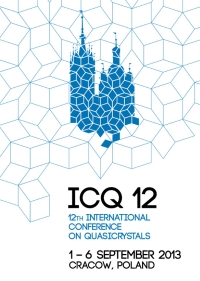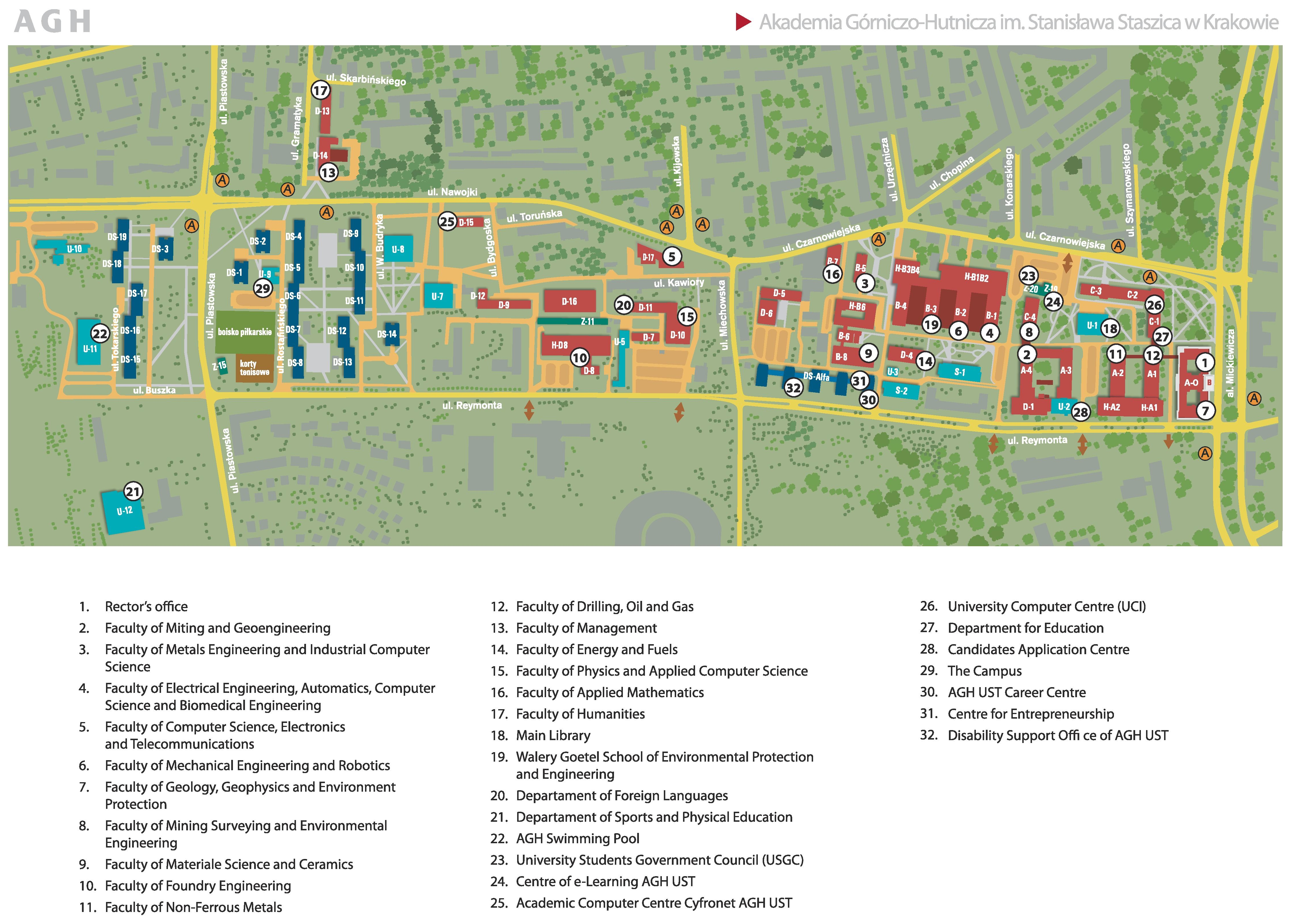
Conference venue
The conference will take place in a building of the Faculty of Physics and Applied Computer Science of AGH University of Science and Technology in Krakow (building D-10, see on a map)
Address: 19 Reymonta Street, 30-059 Krakow, Poland
All tutorials, lectures, poster sessions and welcome, garden or grill parties,
as well as lunches, will take place in the Faculty building D-10 or in a conference tent in a building's surrounding.
In the building D-10 the Wi-Fi internet access is possible (open network AGH-Guest and Eduroam).
The Celebration of AGH Honorary Doctorate to Prof. Dan Shechtman will take place in the AGH assembly hall in a building A-0 (Address: 30 Mickiewicza Avenue, Krakow)
Gala Dinner will take place in Szara Kazimierz Restaurant (Address: 39 Szara Street, Krakow)
Click map to enlarge.

About Kraków
Krakow (Cracovia) was established in VII century by a legendary duke Krak.
In the X century the settlement was already well developed.
The town of Krakow was located third time on Magdeburg Law in XIII century.
Since mid of XI century till the end of XVI century Krakow was a seat of Polish kings.
In this period the city has been greatly developed.
It became a major cultural and academic center of Central Europe.
The historic centre of Krakow has been inscribed in the UNESCO World Heritage list
as "one of the most outstanding examples of European urban planning,
characterized by the harmonious development and accumulation of elements representing
all architectural styles from the early Romanesque phase up to Modernism".
Modern Krakow, the capital of the Lesser Poland (Malopolska) region,
is one of the major academic and cultural centers of Poland.
It is the most popular tourist destination in the country with very good infrastructure and numerous activities.
A "must see" attraction is a visit to a close by historical salt mine Wieliczka,
yet another UNESCO World Heritage site.
Wieliczka Salt Mine is the only mining site in the world functioning continuously since Middle Ages.
Around 100 km south of Krakow, at the border with Slovakia, there are the Tatra Mountains.
The area is well known for winter sports and mountaineering.
.jpg)
Where in Europe will you come across the only desert? Where can you find unique museum collections and witness unusual customs?
Where will nature amaze you with its diversity? The answer is simple – only in Małopolska!
Kraków – the region’s beating heart...
Małopolska is the region with the highest number of historical sites in Poland, the birthplace of Polish culture,
a place that fosters traditions and possesses varied natural endowments. The capital of Małopolska is Kraków, in the past a kings’ residence and today the
region’s artistic and intellectual centre. It’s the city described by Pope John Paul II as the synthesis of everything that’s Polish.
This is just the beginning of an unforgettable journey across the region…

Wawel Castle, photo: T. Gębuś
The underground world
Ten kilometres away from Kraków there is a historical mine in Wieliczka,
where salt has been mined continuously since the 11th century. The Wieliczka Salt Mine is
one of the biggest tourist attractions in Poland, inscribed on the first UNESCO World Heritage
List in 1978. The mine tourist route is almost 2 km long and leads through 22 chambers, e.g.
St Kinga’s Chapel (which can seat 500 people!)

Wieliczka Salt Mine, photo: T. Gębuś
Remembrance monument
In Małopolska one can find the Auschwitz-Birkenau concentration camp, also
entered into the UNESCO World Heritage Sites. This shocking memorial from
World War Two functions today as a museum. This is also a place for contemplation
and prayer for the throngs of visitors who come here.

Auschwitz-Birkenau, photo: M. Grychowski
Along a mountains trail, along a mountains slope…
Małopolska, thanks to its exceptional geographical location and varied surface
features with dominant mountains and uplands, has the best conditions for climbing
in Poland. The Tatras – Poland’s only alpine type mountain range –
stretch out in the region’s southern part. Extremely beautiful, young, dangerous
to frivolous people, demanding. In the Tatras Polish alpinists and mountain climbers
acquire knowledge that leads to the tops of the world.
In Małopolska, there are scores of ski centres, tens of slopes and hundreds of ski lifts
. Winter in Małopolska means also unforgettable cultural and sports events such as the famous
Kraków Christmas Fair, Highlanders’ Carnival in Bukowina Tatrzańska, and the World
Ski-Jumping Cup in Zakopane.

Tatras, photo: T. Gębuś
The enchanted world of wood
The Wooden Architecture Trail in the Małopolska Region is a unique proposal for
the protection of the world made of wood. Entire architectural complexes are
protected in the region – from churches, Orthodox churches, chapels and
belfries, to granaries, rural huts and noblemen’s manors. The greatest treasures
of the region are churches in Sękowa, Binarowa, Lipnica Murowana and Dębno Podhalańskie - UNESCO sites.

Wooden Architecture Trail, photo: P. Droździk
Bon appetite
The delicacies of Małopolska – finger-licking good! Once famous mainly on the Polish market,
today appear on the tables of European gourmets. Ten products, i.a. bryndza podhalańska
(soft cheese made of sheep’s milk), oscypek (smoked sheep cheese) or Lisiecka sausage have
been entered into the EU register of reserved origin names.

Oscypek, photo: P. Droździk
The lights don’t go out
The hard-working and resourceful residents of Małopolska can have great fun as well. He who hasn’t floated the Dunajec River gorge in the Pieniny Mountains at the beginning of the raft season should absolutely do so.

Dunajec River gorge, photo: T. Gębuś
Here, a wedding that lasts even several days can happen, and Łemko people from all over Europe
celebrate their Watra in Zdynia. Here, Kraków Kazimierz celebrates the Jewish Culture Festival.
In Kraków, street theatres, classical music festivals and film competitions feel at home.
Sacrum Profanum and Misteria Paschalia attract tourists from the remotest parts of Europe,
and the Cracovia Marathon is the third, after London and Paris, biggest sporting event of this kind in Europe.

Jewish Culture Festival, photo: P. Mazur
Closer than you think…
2-hour flight and you’re here. Spring, summer, autumn, winter –
Małopolska invites you in every season of the year. Exceptional
treasures wait to be discovered!
Visit Małopolska!
.jpg)